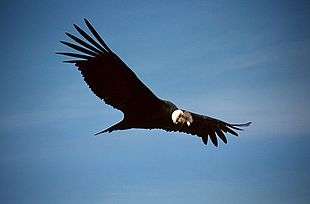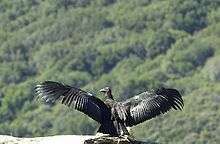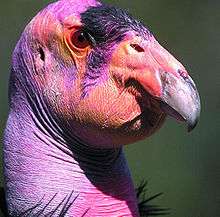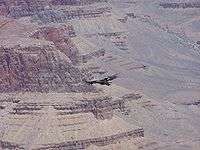Condor
| Condor Temporal range: 2.6–0 Ma | |
|---|---|
 | |
| Andean condor soars over southern Peru's Colca Canyon | |
| Scientific classification | |
| Kingdom: | Animalia |
| Phylum: | Chordata |
| Class: | Aves |
| Order: | Cathartiformes |
| Family: | Cathartidae |
| Genera | |
Condor is the common name for two species of New World vultures, each in a monotypic genus. The name derives from the Quechua kuntur.[1][2] They are the largest flying land birds in the Western Hemisphere.
They are:
- The Andean condor (Vultur gryphus) which inhabits the Andean mountains.
- The California condor (Gymnogyps californianus) currently restricted to the western coastal mountains of the United States and Mexico and the northern desert mountains of Arizona in the United States.
Taxonomy

Condors are part of the family Cathartidae, whereas the 15 species of Old World vultures are in the family Accipitridae, that also includes hawks, eagles, and kites. The New World and Old World vultures evolved from different ancestors. However, they both are carrion-eaters and have distinctive bare heads.
Description
Both condors are very large broad-winged soaring birds, the Andean condor being 5 cm shorter (beak to tail) on average than the northern species, but larger in wingspan. California condors are the largest flying land birds in North America. The Andean condor is second only to the wandering albatross (up to 3.5 m) in terms of wingspan among all living flying birds.[3][4]
The adult plumage is uniformly black, with the exception of a frill of white feathers nearly surrounding the base of the neck which are meticulously kept clean by the bird. As an adaptation for hygiene, the condor's head and neck have few feathers, which exposes the skin to the sterilizing effects of dehydration and solar ultraviolet light at high altitudes. The head is much flattened above. In the male it is crowned with a caruncle or comb, while the skin of the neck in the male lies in folds, forming a wattle. The skin of the head and neck is capable of flushing noticeably in response to emotional state, which serves to communicate between individuals.


The middle toe is greatly elongated, and the hinder one but slightly developed, while the talons of all the toes are comparatively straight and blunt. The feet are thus more adapted to walking as in their relatives the storks , and of little use as weapons or organs of prehension as in birds of prey and Old World vultures. The female, contrary to the usual rule among birds of prey, is smaller than the male.
Although it is on average about five cm shorter from beak to tail than the California condor, the Andean condor is larger in wingspan, ranging from 274 to 310 cm (8.99 to 10.17 ft)[5] and heavier, reaching up to 11 to 15 kg (24 to 33 lb) for males and 7.5 to 11 kg (17 to 24 lb) for females.[6] Overall length can range from 117 to 135 cm (46 to 53 in)[7] Measurements are usually taken from specimens reared in captivity.[5]
California condors' wingspan measures up to 2.9 m (9.5 ft), and they can weigh up to 10.4 kg (23 lb). The skin on the necks will vary in color, depending on the age of the birds. Adult birds' skin color can range from cream, pink, yellow, or even orange during breeding season.
Fossil record
Fossils from the Pleistocene era have been found in various parts of North America, including New York and Florida, leading scientists to believe that California condors or their ancestors once lived on the west coast of North America as well as all the way to the eastern coast. Some scientists also believe that an ancient relative of the condor, Argentavis magnificens from South America, may have been the largest flying bird ever with a wingspan of 7 metres (23 ft).[8]
Behavior
Sexual maturity and breeding behavior do not appear in the condor until 5 or 6 years of age. They may live for 50 years or more, and mate for life. The world's oldest condor died at 100 in the Jardin d'Essai du Hamma in Algiers.[9]
The young are covered with a grayish down until they are almost as large as their parents. They are able to fly after six months, but continue to roost and hunt with their parents until age two, when they are displaced by a new clutch. There is a well-developed social structure within large groups of condors, with competition to determine a 'pecking order' by body language, competitive play behavior, and a wide variety of vocalizations, even though the condor has no voice box.
On the wing the movements of the condor are graceful. The lack of a large sternum to anchor correspondingly large flight muscles identifies it physiologically as a primary soarer. The birds flap their wings on rising from the ground, but after attaining a moderate elevation they seem to sail on the air.
Wild condors inhabit large territories, often traveling 250 km (160 mi) a day in search of carrion. They prefer large carcasses such as deer or cattle which they spot by looking for other scavengers, which cannot rip through the tougher hides of these larger animals with the efficiency of the larger condor. In the wild they are intermittent eaters, often going for a few days without eating, then gorging themselves on several kilograms at once, sometimes to the point of being unable to lift off the ground.
Other
The Moche people of ancient Peru worshiped nature.[10] They placed emphasis on animals and often depicted condors in their art.[11]
In Golf, a Condor is a hole in one on a Par 5 or taking two shots on the uncommon Par 6. Only four have been recorded to have happened due to their extreme rarity.
Gallery
 California condor's head
California condor's head California condor in flight over the Grand Canyon.
California condor in flight over the Grand Canyon.- Condor flying alone in the Grand Canyon, Arizona
 Numbered condor in Grand Canyon, Arizona
Numbered condor in Grand Canyon, Arizona Moche condor. 300 AD. Larco Museum Collection Lima, Peru
Moche condor. 300 AD. Larco Museum Collection Lima, Peru
References
- ↑ J. Simpson; E. Weiner, eds. (1989). "Raven". Oxford English Dictionary (2nd ed.). Oxford: Clarendon Press. ISBN 0-19-861186-2.
- ↑ "A Quechua metaphor for a plane: Kuntur-man = "looking like a Condor"". Quechua.org.uk. Retrieved 2010-03-20.
- ↑ Robertson, C. J. R. (2003). "Albatrosses (Diomedeidae)". In Hutchins, Michael. Grzimek's Animal Life Encyclopedia. 8 Birds I Tinamous and Ratites to Hoatzins (2 ed.). Farmington Hills, MI: Gale Group. pp. 113–116, 118–119. ISBN 0-7876-5784-0.
- ↑ Dunn, Jon L.; Alderfer, Jonathon (2006). "Accidentals, Extinct Species". In Levitt, Barbara. National Geographic Field Guide to the Birds of North America (fifth ed.). Washington D.C.: National Geographic Society. p. 467. ISBN 978-0-7922-5314-3.
- 1 2 Ferguson-Lees, James; Christie, David A. (2001). Raptors of the World. Boston: Houghton Mifflin. ISBN 0-618-12762-3.
- ↑ Lutz, Dick; Lutz, Richard L. (2002). Patagonia: At the Bottom of the World. DIMI Press. pp. 71–74. ISBN 0-931625-38-6.
- ↑ Hilty, Stephen L. (1977). A Guide to the Birds of Colombia. Princeton University Press. p. 88. ISBN 0-691-08372-X.
- ↑ Campbell,K.E. & Tonni, E.P. 1983. Size and locomotion in teratorns (Aves: Teratornithidae). Auk. 1983; 100(2): 390-403
- ↑ "The world's oldest condor dies". Ennahar Online. 2010-07-28. Retrieved 2014-06-02.
- ↑ Benson, Elizabeth. The Mochica: A Culture of Peru. New York: Praeger Press, 1972.
- ↑ Berrin, Katherine & Larco Museum. The Spirit of Ancient Peru:Treasures from the Museo Arqueológico Rafael Larco Herrera. New York: Thames and Hudson, 1997.
External links
| Wikimedia Commons has media related to Andean condor. |
| Wikimedia Commons has media related to California condor. |
| Wikispecies has information related to: Andean condor |
| Wikispecies has information related to: California condor |
- BirdLife Species Factsheet Andean Condor
- BirdLife Species Factsheet California Condor
- California Condor Conservation
- Condor
- Scientists Work to Repopulate Colombia's Skies with Condors - slideshow by the Los Angeles Times
- Ventana Wildlife Society: Condor Recovery
![]() The dictionary definition of condor at Wiktionary
The dictionary definition of condor at Wiktionary